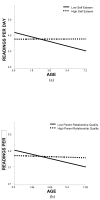A focus on blood glucose monitoring: relation to glycemic control and determinants of frequency
- PMID: 20522169
- PMCID: PMC2935500
- DOI: 10.1111/j.1399-5448.2010.00663.x
A focus on blood glucose monitoring: relation to glycemic control and determinants of frequency
Abstract
Objective: To re-examine the relation of blood glucose monitoring to glycemic control among adolescents with type 1 diabetes and to evaluate the relation of demographic, behavioral, and psychosocial characteristics of adolescents who monitor more and less frequently.
Research design and methods: Participants were 132 adolescents with type 1 diabetes (average age = 12 yr) and their parents, recruited from Children's Hospital of Pittsburgh. Adolescents were interviewed annually for five consecutive years after routine clinic appointments. At each assessment, data from blood glucose meters were downloaded and glycosylated hemoglobin A1c was recorded from medical records.
Results: More frequent blood glucose monitoring was related to better glycemic control. Adolescents who monitored more frequently were younger, from higher social status families, on insulin pumps, and had higher self-efficacy. Age-related declines in blood glucose monitoring occurred among adolescents with low self-esteem, high stressful life events, and lower parental support.
Conclusions: Given the importance of blood glucose monitoring for good glycemic control, future research should enhance adolescents' self-efficacy for monitoring and intervene with those who are at risk for age-related declines in blood glucose monitoring.
© 2010 John Wiley & Sons A/S.
Figures


Similar articles
-
Effect of Financial Incentives on Glucose Monitoring Adherence and Glycemic Control Among Adolescents and Young Adults With Type 1 Diabetes: A Randomized Clinical Trial.JAMA Pediatr. 2017 Dec 1;171(12):1176-1183. doi: 10.1001/jamapediatrics.2017.3233. JAMA Pediatr. 2017. PMID: 29059263 Free PMC article. Clinical Trial.
-
The effectiveness of continuous subcutaneous insulin pumps with continuous glucose monitoring in outpatient adolescents with type 1 diabetes: A systematic review.JBI Libr Syst Rev. 2012;10(42 Suppl):1-10. doi: 10.11124/jbisrir-2012-170. JBI Libr Syst Rev. 2012. PMID: 27820140
-
Parental involvement in diabetes management tasks: relationships to blood glucose monitoring adherence and metabolic control in young adolescents with insulin-dependent diabetes mellitus.J Pediatr. 1997 Feb;130(2):257-65. doi: 10.1016/s0022-3476(97)70352-4. J Pediatr. 1997. PMID: 9042129
-
Depressive symptoms predict change in glycemic control in adolescents with type 1 diabetes: rates, magnitude, and moderators of change.Pediatr Diabetes. 2011 Dec;12(8):718-23. doi: 10.1111/j.1399-5448.2011.00771.x. Epub 2011 May 12. Pediatr Diabetes. 2011. PMID: 21564454
-
Measures of Adherence and Challenges in Using Glucometer Data in Youth with Type 1 Diabetes: Rethinking the Value of Self-Report.J Diabetes Res. 2017;2017:1075428. doi: 10.1155/2017/1075428. Epub 2017 Dec 21. J Diabetes Res. 2017. PMID: 29430465 Free PMC article.
Cited by
-
Family involvement with the diabetes regimen in young people: the role of adolescent depressive symptoms.Diabet Med. 2013 May;30(5):596-602. doi: 10.1111/dme.12117. Epub 2013 Mar 7. Diabet Med. 2013. PMID: 23320523 Free PMC article.
-
Analysis article: accuracy of the DIDGET glucose meter in children and young adults with diabetes.J Diabetes Sci Technol. 2011 Sep 1;5(5):1164-6. doi: 10.1177/193229681100500519. J Diabetes Sci Technol. 2011. PMID: 22027311 Free PMC article.
-
Identification and prediction of group-based glycemic control trajectories during the transition to adolescence.Health Psychol. 2014 Oct;33(10):1143-52. doi: 10.1037/hea0000025. Epub 2013 Nov 25. Health Psychol. 2014. PMID: 24274797 Free PMC article.
-
Risk factors for occurrence and recurrence of diabetic foot ulcers among Iraqi diabetic patients.Diabet Foot Ankle. 2016 Mar 15;7:29605. doi: 10.3402/dfa.v7.29605. eCollection 2016. Diabet Foot Ankle. 2016. PMID: 26983600 Free PMC article.
-
Positive psychological characteristics in diabetes: a review.Curr Diab Rep. 2013 Dec;13(6):917-29. doi: 10.1007/s11892-013-0430-8. Curr Diab Rep. 2013. PMID: 24048687
References
-
- Mann NP, Noronha JL, Johnston DI. A prospective study to evaluate the benefits of long-term self-monitoring of blood glucose in diabetic children. Diabetes Care. 1984;7:322–326. - PubMed
-
- Schiffrin A, Belmonte M. Multiple daily self-glucose monitoring: Its essential role in long-term glucose control in insulin-dependent diabetic patients treated with pump and multiple subcutaneous injections. Diabetes Care. 1982;5:479–484. - PubMed
-
- Levine BS, Anderson BJ, Butler DA, Antisdel JE, Brackett J, Laffel LMB. Predictors of glycemic control and short-term adverse outcomes in youth with type 1 diabetes. J Pediatr. 2001;139:197–203. - PubMed
-
- Dorchy H, Roggemans MP, Willems D. Glycated hemoglobin and related factors in diabetic children and adolescents under 18 years of age: a Belgian experience. Diabetes Care. 1997;20:3–6. - PubMed
-
- Dorchy H. Personal communication. 2008
Publication types
MeSH terms
Substances
Grants and funding
LinkOut - more resources
Full Text Sources
Medical

